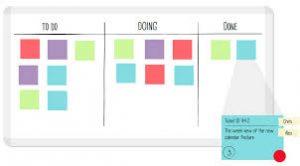A personal project of mine that I have been working on is to implement Visual Management around my home. Too often I was finding myself with priority things needing to be done all at once. I would have loads (at least two) of laundry to do at time, chores piled up, all along with homework and readings to be done for class. The thing is, I was trying to do most of these things at the last minute, and it all needed to be done NOW.
I decided I wanted to change my situation, and in a Lean way. I mean, I implemented Lean and tried different experiments often at work, why should it be any different at home?
My current situation was that things just weren’t getting done, even though I was “using” tools such as Google Calendar and setting aside specific times to do things. I tried other uses of Visual Management such as putting together a large kanban board, making a huge (yet complicated) whiteboard calendar, detailing my Google Calendar Further, etc. However, none of these stuck. The kanban? I never took the time to use. The whiteboard calendar? It was over-complicated and took a lot of time to update. Detailing my Google Calendar? That didn’t help because I didn’t look at it beyond classwork once I was home. Overall, it just seemed like I wasn’t using anything and nothing was sticking. I liked the work of putting together a board that looked nice and was filled with all my tasks, but then it became daunting, and then I didn’t use it at all.
I began to see a trend of over-processing and no sustainment. The over-processing happens when I make a tool that is supposed to be helpful, so complicated that it no longer is. My whiteboard took more time to update than it did to look at anything, making it neither efficient nor helpful. I didn’t stick to taking five minutes out of my day to add a sticky note or two to my kanban, so I didn’t sustain it and tasks were forgotten. Recognizing these things didn’t make me feel bad (it happens!) but it did fuel my resolve to keep trying to find something that does work for me. Sometimes we find that our Visual Management has morphed into something that is more work than help, and that’s okay. PDCA and try a new experiment in another way.
So that’s what I have been doing, starting fresh with a new, simple kanban board. Funny thing is, I’ve done the same thing at work! I’ve also been experimenting with different types of Visual Management: putting a line across the hamper to trigger when a full load is, being messy with reminder notes, and making separate calendars for things such as homework and readings. Visual Management may look different between two people, so experiment with finding what works for you.
Do you use Visual Management in a different way? Are there certain tools or exercises that you use to help you? We’d love to hear more from you, feel free to share in the comments below!

Dominique, I love your story of intention, reflection, experimentation and learning. I, too, really want to use visual management more purposefully and have gone through many, many learning and improvement cycles….and I’m still learning, reflecting, and experimenting. Thanks for sharing your journey.
Lean at home is so fun! Once I took data on my laundry schedule and found out I did more re-work if I started washing clothes after 7PM (re-drying them to get out wrinkles, one night of laundry turned into two, etc.). Seeing that data was key for me. I encourage you to do a little more data collection/analyzing to narrow your root cause, then do some countermeasure brainstorming…Maybe a smaller laundry basket and make the dirty clothes more visual if you like an aesthetically pleasing area. Or lower your clothing par levels to be a bit more drastic! 🙂
It’s been a learning experience, that is for sure! Those are all excellent suggestions and I will take them to heart. Data collection really makes the issues, and later the change, visible. Thank you for your comment!